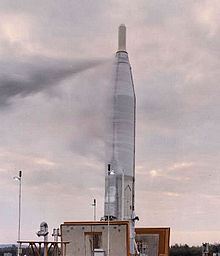| Atlas F (SM-65F, HGM-16F) Missile housed in an vertical silo with adjoining control center, hardened to 100 psi overpressure. Inertial guidance system. Filled with RP-1 while it sat on alert, LOX added at the start of the countdown, then raised to ground level by the massive silo elevator. The missile was exposed above ground for a much shorter time than earlier configurations. |
Atlas F Units 576th Strategic Missile Squadron (SMS), Vandenberg AFB, California - Two site, one silo each, activated April 1958, closed April 1966. Opened later in other roles. 550th SMS, Schilling AFB, Kansas, activated April 1961, closed June 1965. 551st SMS, Lincoln AFB, Nebraska, activated April 1961, closed June 1965. 577th SMS, Altus AFB, Oklahoma, activated June 1961, closed March 1965. 578th SMS, Dyess AFB, Texas, activated July 1961, closed March 1965. 579th SMS, Walker AFB, New Mexico, activated September 1961, closed March 1965. 556th SMS, Plattsburgh AFB, New York, activated October 1961, closed March 1965. Each Operational base had twelve silos. Three silos, one at Altus and two at Walker, were destroyed by accidents during propellant loading exercises. |
|



